Micromachining of AlN and Al2O3 Using Fiber Laser
Abstract
:1. Introduction
2. Experimental Section
2.1. The Laser-System
2.2. Materials
3. Results and Discussion
3.1. Ablation Threshold
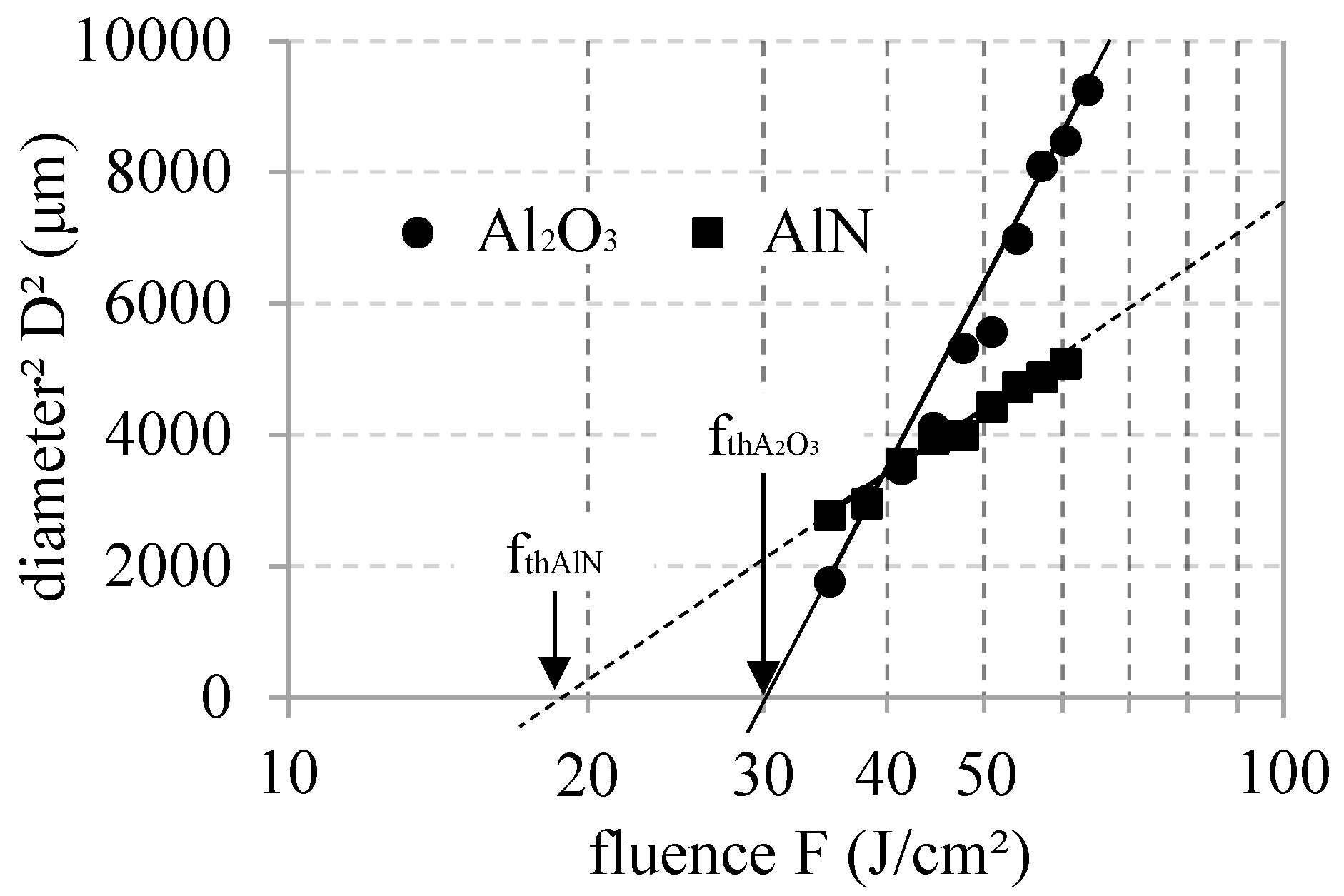
3.2. Correlation between Pulse Overlap and Roughness
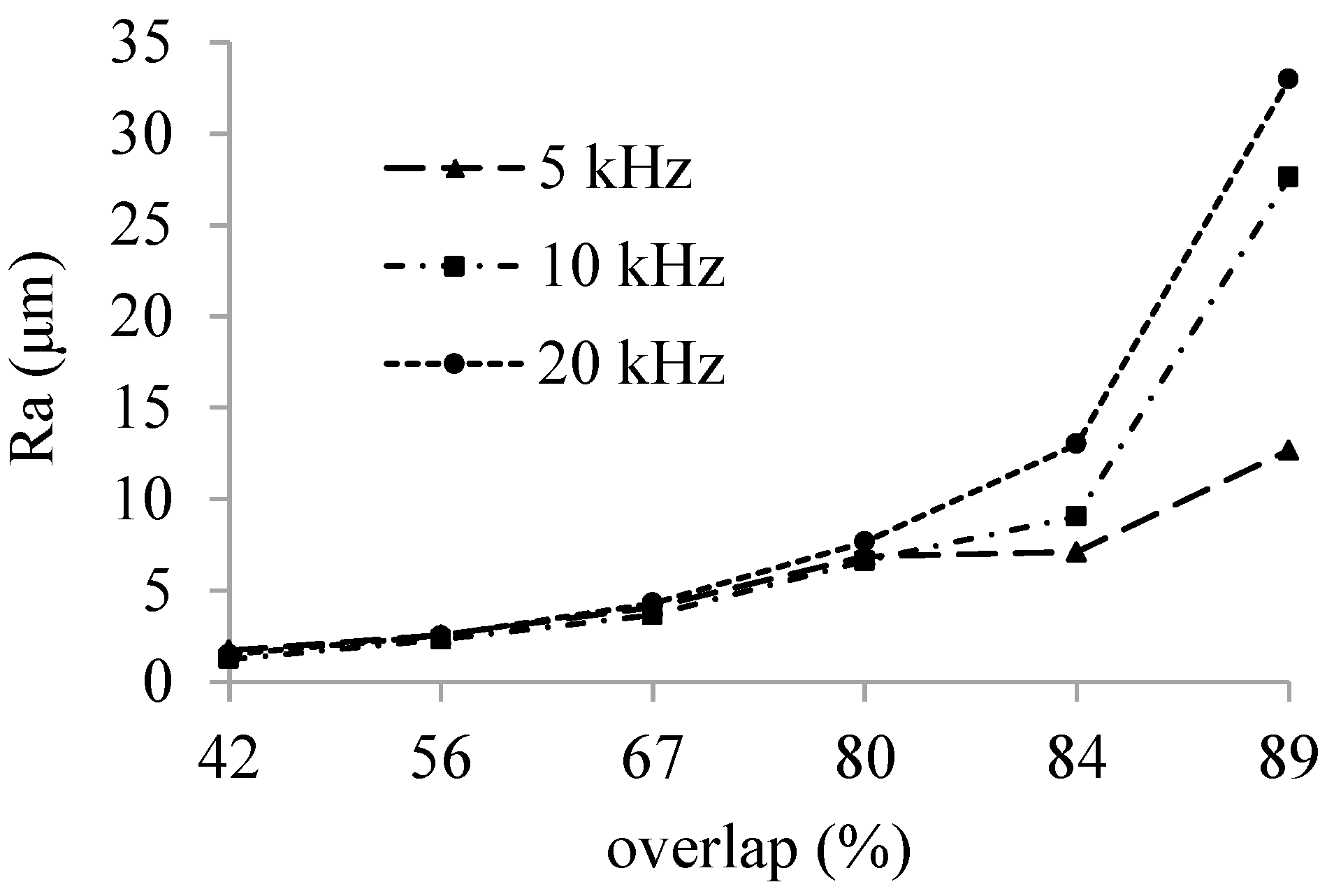
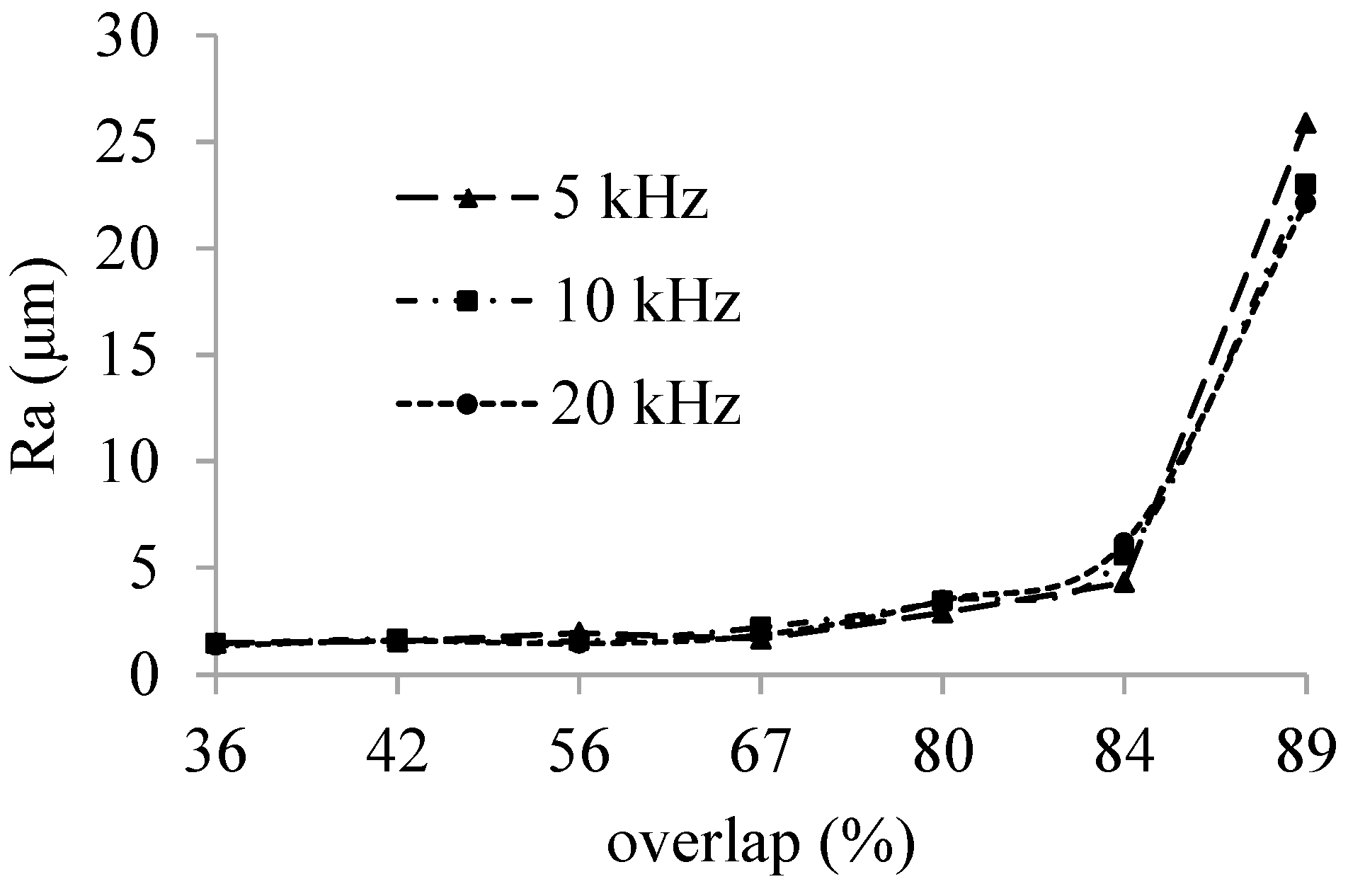
3.3. Material Removal Rate
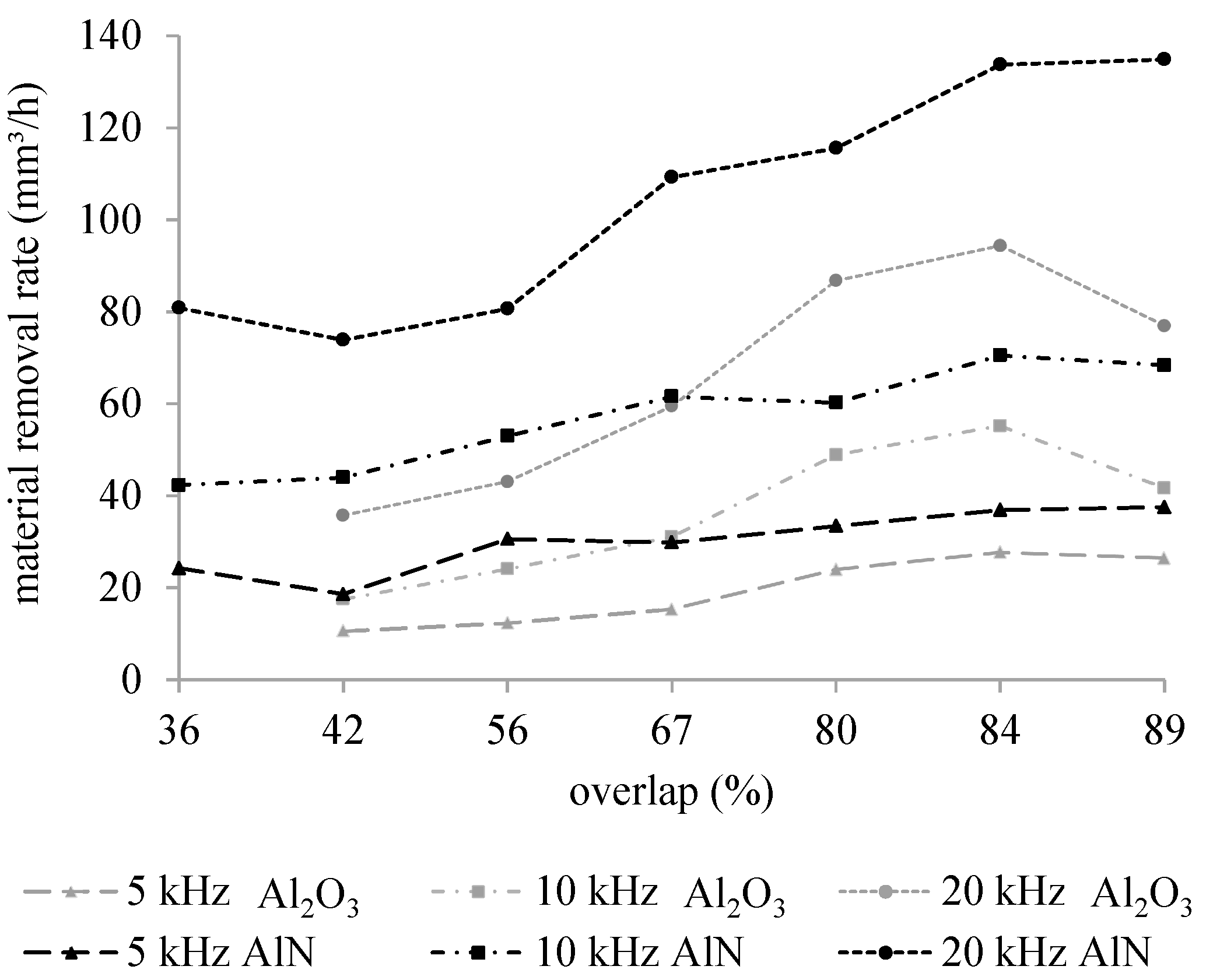
3.4. Ablation Depth Accuracy
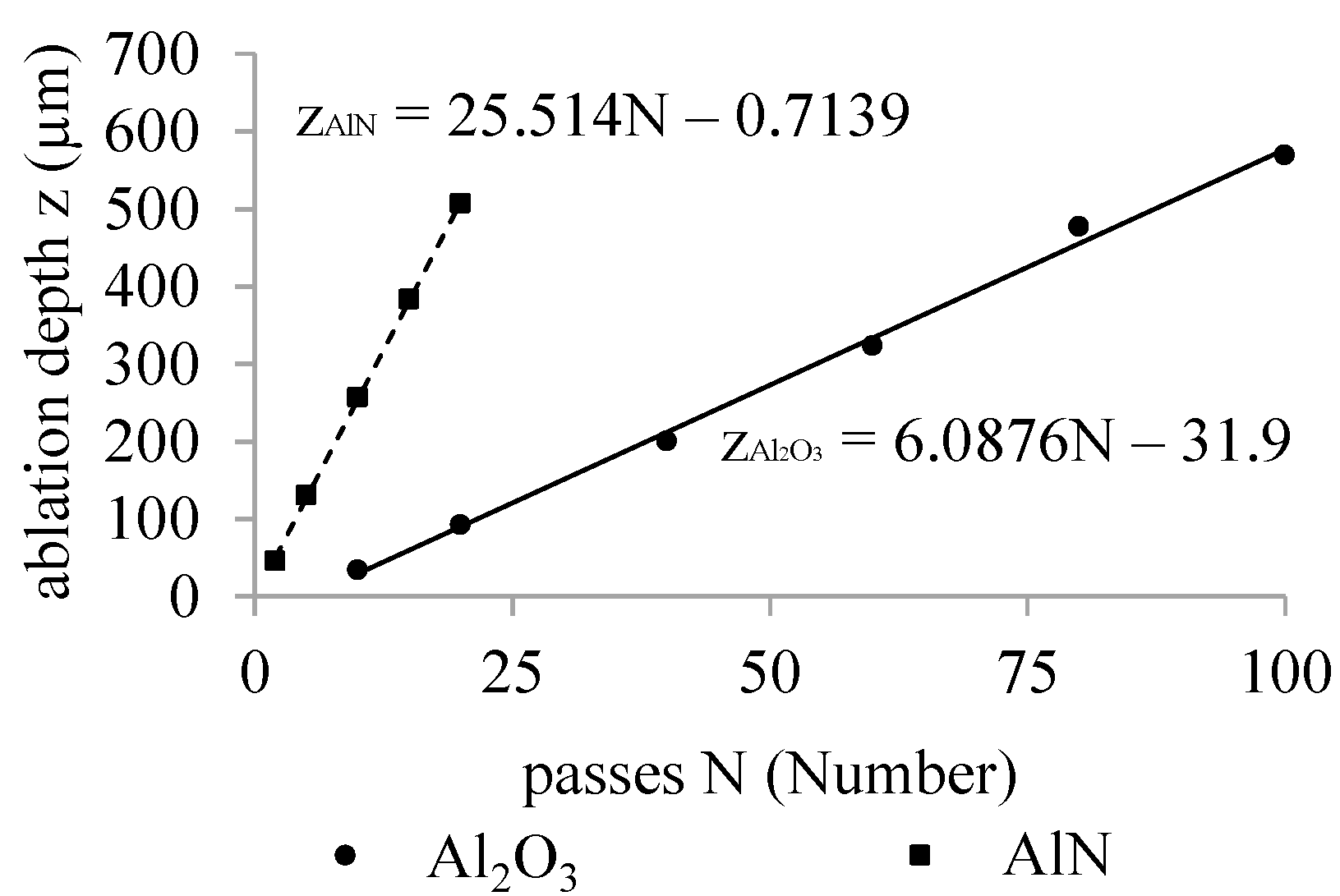
| Characteristic | TARGET (μm) | |||
|---|---|---|---|---|
| 50 | 100 | 300 | 500 | |
| number of passes (N) | 14 | 22 | 55 | 87 |
| calculated (μm) | 53.3 | 102.0 | 302.9 | 497.7 |
| measured (μm) | 49.1 | 95.3 | 287.6 | 482.4 |
| Deviation in % | 7.9 | 6.6 | 5.0 | 3.0 |
| Characteristic | TARGET (μm) | |||
|---|---|---|---|---|
| 50 | 100 | 300 | 500 | |
| number of passes (N) | 2 | 4 | 12 | 20 |
| calculated (μm) | 50.3 | 101.3 | 305.5 | 509.6 |
| measured (μm) | 51.1 | 103.4 | 305.3 | 508.9 |
| Deviation in % | 1.5 | 2.0 | <0.1 | <0.1 |
4. Example of 3D Microstructures
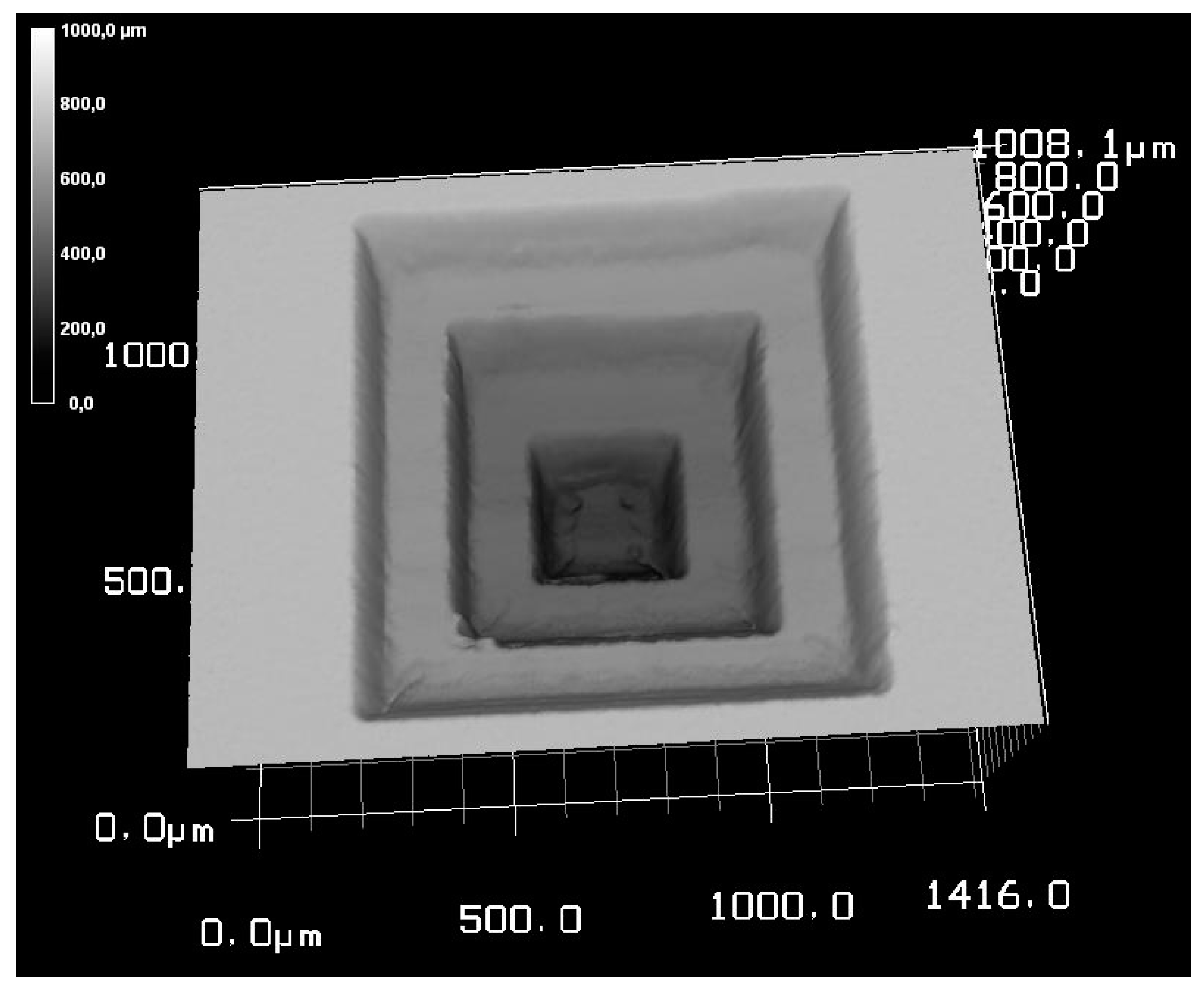
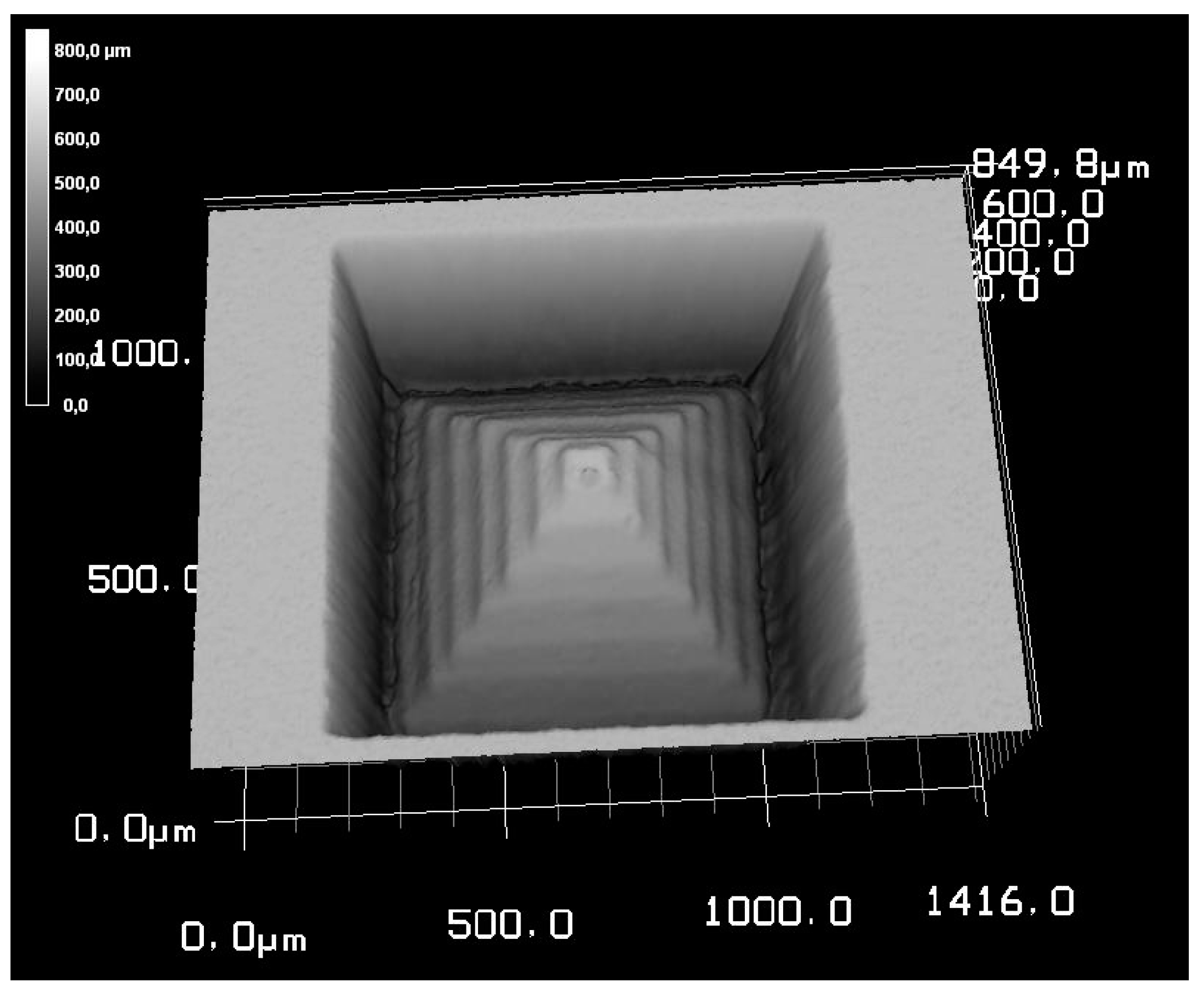
5. Conclusions
Acknowledgments
Author Contributions
Conflicts of Interest
References
- Kibria, G.; Doloi, B.; Bhattacharyya, B. Predictive model and process parameters optimization of Nd: YAG laser micro-turning of ceramics. Int. J. Adv. Manuf. Technol. 2013, 65, 213–229. [Google Scholar] [CrossRef]
- Knowles, M.R.H.; Rutterford, G.; Karnakis, D.; Ferguson, A. Micro-machining of metals, ceramics and polymers using nanosecond lasers. Int. J. Adv. Manuf. Technol. 2007, 33, 95–102. [Google Scholar] [CrossRef]
- Pham, D.T.; Dimov, S.S.; Petkov, P.V. Laser milling of ceramic components. Int. J. Mach. Tools Manuf. 2007, 47, 618–626. [Google Scholar] [CrossRef]
- Adelmann, B.; Hellmann, R. Investigation on flexural strength during fiber laser cutting of alumina. Phys. Procedia 2013, 41, 398–400. [Google Scholar] [CrossRef]
- Samant, A.N.; Narendra, B.D. Laser machining of structural ceramics—A review. J. Eur. Ceram. Soc. 2009, 29, 969–993. [Google Scholar] [CrossRef]
- Molian, R.; Shrotriya, P.; Molian, P. Thermal stress fracture mode of CO2 laser cutting of aluminum nitride. Int. J. Adv. Manuf. Technol. 2008, 39, 725–733. [Google Scholar] [CrossRef]
- Wang, X.; Shephard, J.D.; Dear, F.C.; Hand, D.P. Optimized Nanosecond Pulsed Laser Micromachining of Y-TZP Ceramics. J. Am. Ceram. Soc. 2008, 91, 391–397. [Google Scholar] [CrossRef]
- Vanko, G.; Hudek, P.; Zehetner, J.; Dzuba, J.; Choleva, P.; Kutiš, V.; Vallo, M.; Rýger, I.; Lalinský, T. Bulk micromachining of SiC substrate for MEMS sensor applications. Microelectron. Eng. 2013, 110, 260–264. [Google Scholar] [CrossRef]
- Hirayama, Y.; Yabe, H.; Obara, M. Selective ablation of ALN ceramic using femtosecond, nanosecond, and microsecond pulsed laser. J. Appl. Phys. 2001, 89, 2943–2949. [Google Scholar] [CrossRef]
- Weichenhain, R.; Horn, A.; Kreutz, E.W. Three dimensional microfabrication in ceramics by solid state lasers. Appl. Phys. A 1999, 69, 855–858. [Google Scholar] [CrossRef]
- Sciti, D.; Melandri, A.; Bellosi, A. Excimer laser-induced microstructural changes of alumina and silicon carbide. J. Mater. Sci. 2000, 35, 3799–3810. [Google Scholar] [CrossRef]
- Oliveira, V.; Vilar, R.; Conde, O. Excimer laser ablation of Al2O3—TiC ceramics: Laser induced modifications of surface topography and structure. Appl. Surf. Sci. 1998, 127, 831–836. [Google Scholar] [CrossRef]
- Ihlemann, J.; Wolff-Rottke, B. Excimer laser micro machining of inorganic dielectrics. Appl. Surf. Sci. 1996, 106, 282–286. [Google Scholar] [CrossRef]
- Shah, L.; Fermann, M.E.; Dawson, J.W.; Barty, C.P.J. Micromachining with a 50 W, 50 μJ, subpicosecond fiber laser system. Opt. Express 2006, 14, 12546–12551. [Google Scholar] [CrossRef] [PubMed]
- Liu, J.M. Simple technique for measurements of pulsed Gaussian-beam spot sizes. Opt. Lett. 1982, 7, 196–198. [Google Scholar] [CrossRef] [PubMed]
- Martin, S.; Hertwig, A.; Lenzner, M.; Krüger, J.; Kautek, W. Spot-size dependence of the ablation threshold in dielectrics for femtosecond laser pulses. Appl. Phys. A 2003, 77, 883–884. [Google Scholar] [CrossRef]
- Torrisi, L.; Borrielli, A.; Margarone, D. Study on the ablation threshold induced by pulsed lasers at different wavelengths. Nucl. Instrum. Methods Phys. Res. Sect. B Beam Interact. Mater. At. 2007, 255, 373–379. [Google Scholar] [CrossRef]
- Borowiec, A.; Tiedje, H.F.; Haugen, H.K. Wavelength dependence of the single pulse femtosecond laser ablation threshold of indium phosphide in the 400–2050 nm range. Appl. Surf. Sci. 2005, 243, 129–137. [Google Scholar] [CrossRef]
- Kautek, W.; Krüger, J.; Lenzner, M.; Sartania, S.; Spielmann, C.; Krausz, F. Laser ablation of dielectrics with pulse durations between 20 fs and 3 ps. Appl. Phys. Lett. 1996, 69, 3146–3148. [Google Scholar] [CrossRef]
- Stuart, B.C.; Feit, M.D.; Rubenchik, A.M.; Shore, B.W.; Perry, M.D. Laser-induced damage in dielectrics with nanosecond to subpicosecond pulses. Phys. Rev. Lett. 1995, 74, 2248. [Google Scholar] [CrossRef] [PubMed]
- Kim, S.H.; Sohn, I.k.; Jeong, S. Ablation characteristics of aluminum oxide and nitride ceramics during femtosecond laser micromachining. Appl. Surf. Sci. 2009, 255, 9717–9720. [Google Scholar] [CrossRef]
- Bengisu, M. Engineering Ceramics; Springer: Heidelberg, Germany, 2001. [Google Scholar]
- Hellrung, D. Material Removal by Laser Radiation for the Fabrication of Three Dimensional Micro Molding Tools Made of Hard Materials. Ph.D. Thesis, RWTH Aachen University, Aachen, Germany, 2000. [Google Scholar]
© 2014 by the authors; licensee MDPI, Basel, Switzerland. This article is an open access article distributed under the terms and conditions of the Creative Commons Attribution license (http://creativecommons.org/licenses/by/4.0/).
Share and Cite
Preusch, F.; Adelmann, B.; Hellmann, R. Micromachining of AlN and Al2O3 Using Fiber Laser. Micromachines 2014, 5, 1051-1060. https://doi.org/10.3390/mi5041051
Preusch F, Adelmann B, Hellmann R. Micromachining of AlN and Al2O3 Using Fiber Laser. Micromachines. 2014; 5(4):1051-1060. https://doi.org/10.3390/mi5041051
Chicago/Turabian StylePreusch, Florian, Benedikt Adelmann, and Ralf Hellmann. 2014. "Micromachining of AlN and Al2O3 Using Fiber Laser" Micromachines 5, no. 4: 1051-1060. https://doi.org/10.3390/mi5041051




